It’s one of the necks you’ve always heard about, likely never seen and may never see. Fly shops still maintain pecking orders, some small vestiges of times past, but rare colors require blood kinship – as they’ll never make it past the avaricious mitts of the staff.
It’s the Holy Grail of fly tying and most older books devote whole chapters to the quest of securing enough dun hackle to feel contentment. As most of the old timers were conspicuous hoarders, even plenty wasn’t nearly enough.

You’ve substituted for them since you began tying, usually with regular dun and the offshore fly tying companies have done similar. Many legendary flies are no longer true to pattern because the rarer hues of Iron Blue, Bronze, and Honey Dun, still aren’t readily available and certainly not enough to tie the legions of flies needed commercially.
An occasional cape slips into the Whiting mix, but they rarely make it to the street. Once the proprietor and his staff are satiated a rare color begats a phone call to specific patrons – alerting them to their presence.
Dun necks were dyed prior to the advent of genetic hackle. Commercial fly tiers could sort through thousands of India capes to find only an occasional dun, but white and cream were plentiful and many thousands of capes were slipped into gray RIT or TINTEX to satisfy demand.
From the earliest genetic efforts of the Darbee’s and the Catskill coven, Whiting, Hoffman, Metz, and other chicken farmers developed a plentiful supply for the standard light, medium, and dark, dun with most shops now having a regular supply in both neck and saddle.
When the early strains of these birds debuted in the 80’s, the only commercial offering was from the Metz company. Henry Hoffman was still focused on the perfect Grizzly (among other colors) and most of the Dun necks were only half Dun – the feather tips were nicely colored, but the butts were often white.
Fly tiers fought and begged for the necks uniform in color, but only 15% to 20% of a dun shipment were fully colored. The Blue Andalusian strain was also much leaner of barbule, and spreading a feather would show less barbules per inch than the robust breeds like Grizzly, Ginger, or Rhode Island Red.
Those early chickens could tie far fewer flies than those available today.
Dyeing Dun necks often yielded a superior feather, especially when light barred Grizzly or Ginger was used as the base color. Having a few darker strands in a Hendrickson never hurt much, and Metz Ginger necks were plentiful and easy to come by, they’d be last on the rack after the hordes of tiers had picked through everything else.
Those of us willing to risk the $45 were richly rewarded, as we pulled rare colors out of the dye bath, those self-same colors unavailable today.
The Contemplative Angler outlines many shades of Dun and some of the history behind all the variants. There’s little secret to achieving Honey Dun or a good bronze flavor; shell out the $85 for a nicely marked cream or ginger neck and plunk it in a dye bath.
Some of my past pieces on dyeing covers the rudiments of water temperature, color, and dye selection, the rules are the same only the dollar values increase; good preparation, a known dye, and using some rudimentary lessons from cooking school …
Chicken skin is fragile, treat it as such
A chef is trained to warm a dish or reheat an entree by using a lower temperature than was used originally. It makes perfect sense as the meat is cooked to a certain point by the initial temperature, and will continue cooking if the reheating temperature is raised to equal or greater.
Preserving those rare and medium rare cuts of Prime Rib is important given much of the cooking and preparation is done prior to the customer ordering the dish.
A chicken neck is just skin and feather follicles that have been treated and dried by the grower to remain flexible, it can be cooked further if the bath temperature is too hot.
It’s really the only mistake you can make if unfamiliar with dyeing necks, chicken skin cooks at lower temperatures than elk hide or heavier items, and when dried can shrink as much as 40% in addition to becoming brittle. It’s an imposition mostly, the feather color will be fine but the neck section will snap off the cape if flexed and you’ll have pieces of skin and feathers in the bag, versus an intact neck.
Know the dye, and get a clean color
As Gray is a relatively simple color to dye, it can be done in lukewarm water preventing both shrinkage and brittleness.
The problem with Gray is that it’s a weak black, and comprised of other dark colors which can show unbidden. It can be a “blue” gray or a “red” gray – just like black, so you’ll need to find a clean gray that is free of other tints as is possible.
Test dyeing on cheaper materials is the best way to determine the dried color. Look for a pale gray that allows you to steep the neck for a bit without turning into a shade of charcoal. I’ve found Jacquard’s Silver (gray) to be a really nice color with very few overtones.
The Process of Under-Dyeing
Under-dyeing is simply coaxing the material’s existing colors into something else. Unlike other forms of dyeing we’re not attempting to overpower the material, merely tinting it in the right direction.
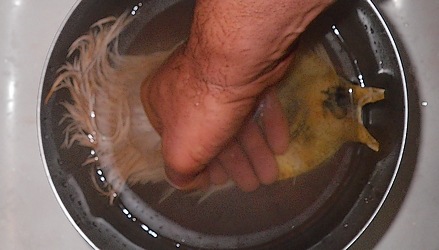
Neck preparation is identical to other materials with hide attached, merely place it feather-side-down in a bowl, cover it with lukewarm water and pump the back of the skin until air bubbles cease coming to the surface. This supersaturates the material so the dye hits all the feathers and duff at the same time, ensuring the same tint to the entire neck.
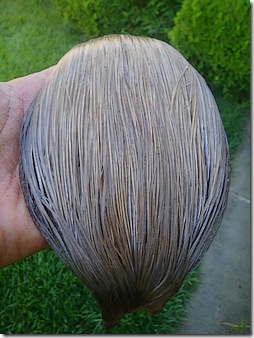 We’ll watch the top half of the hackles to monitor how deep the color will be before pulling the cape from the bath. The webby lower feather absorbs dye greedily and will darken much faster than the harder, shiny tips, often causing us to pull the cape from the dye prematurely. Hackle tips take dye slower, and we’ll pull the neck when the top half of the feather is the color needed.
We’ll watch the top half of the hackles to monitor how deep the color will be before pulling the cape from the bath. The webby lower feather absorbs dye greedily and will darken much faster than the harder, shiny tips, often causing us to pull the cape from the dye prematurely. Hackle tips take dye slower, and we’ll pull the neck when the top half of the feather is the color needed.
This is the most important lesson of dyeing, picking the “action” area of the material to monitor for color change. Wet materials are always darker than dry, but for exacting matches – it’s the useful area that must be watched, not the webby portion.
Above is a damp Ginger neck pulled out of Jacquard Silver dye bath. I warmed the water enough to facilitate dissolving the dye, and removed the heat and added the white vinegar to cool it to merely warm. This is shown in indirect daylight to show the depth of the gray assist.
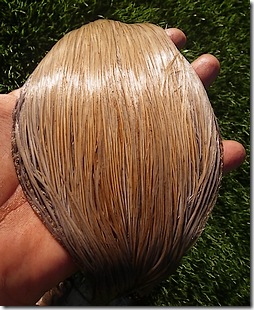 The edges of the cape show the “clean Gray” color – largely absent blue or purplish tinges common to gray or black dye. The ginger center is assisted by the gray to form a really nice tint of honey or bronze dun.
The edges of the cape show the “clean Gray” color – largely absent blue or purplish tinges common to gray or black dye. The ginger center is assisted by the gray to form a really nice tint of honey or bronze dun.
At right is the same damp cape in direct sunlight, which shows the depth of the bronzing or honey color.
A cape this color is a rarity and would fly off the shelf unbidden, little wonder that flies, reels, and even split cane rods were traded for a hint of the proper colors.
The darkness of the Ginger chosen controls the “bronzing” effect on the final color. The dye merely assists the process by laying down a complimentary mask of Gray which acts with the natural color to bring out the final shade. Under-dyeing is really a tinting process designed to preserve the original color while nudging it gently into something quite different.
I still rely heavily on the dyed dun as compared to natural Dun necks or saddles. Their quality has improved a couple hundred fold since the 80’s, yet supply still seems to be an issue. Many shops have an assortment but not all colors are present in the full range of light, medium, and dark.
Ginger necks outnumber Dun by a wide margin, and sometimes I yank a creation out of the dye pot and understand why Art Flick or Roy Steenrod would have given away the farm …
 They’re on the warpath, and with the death of the UK’s famous “Two Tone” carp, PETA erected a billboard to chastise local anglers …
They’re on the warpath, and with the death of the UK’s famous “Two Tone” carp, PETA erected a billboard to chastise local anglers …


 They’re onto me …
They’re onto me …


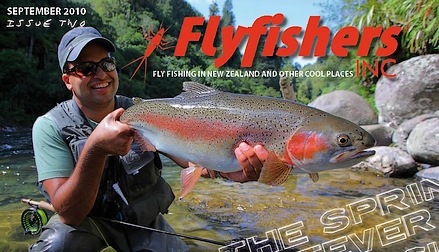


 We’ll watch the top half of the hackles to monitor how deep the color will be before pulling the cape from the bath. The webby lower feather absorbs dye greedily and will darken much faster than the harder, shiny tips, often causing us to pull the cape from the dye prematurely. Hackle tips take dye slower, and we’ll pull the neck when the top half of the feather is the color needed.
We’ll watch the top half of the hackles to monitor how deep the color will be before pulling the cape from the bath. The webby lower feather absorbs dye greedily and will darken much faster than the harder, shiny tips, often causing us to pull the cape from the dye prematurely. Hackle tips take dye slower, and we’ll pull the neck when the top half of the feather is the color needed. The edges of the cape show the “clean Gray” color – largely absent blue or purplish tinges common to gray or black dye. The ginger center is assisted by the gray to form a really nice tint of honey or bronze dun.
The edges of the cape show the “clean Gray” color – largely absent blue or purplish tinges common to gray or black dye. The ginger center is assisted by the gray to form a really nice tint of honey or bronze dun.

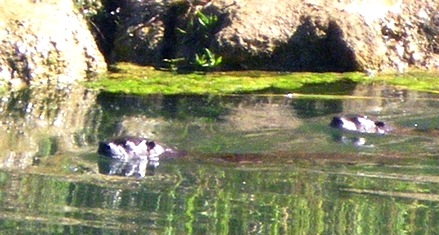

 Just a friendly reminder that Monday, September 6th is the second of the
Just a friendly reminder that Monday, September 6th is the second of the